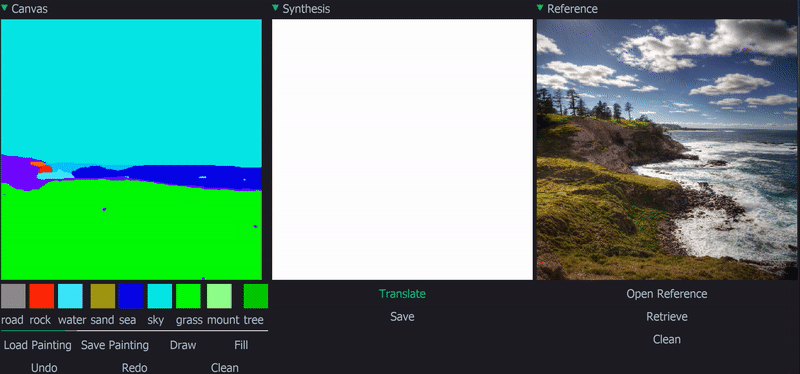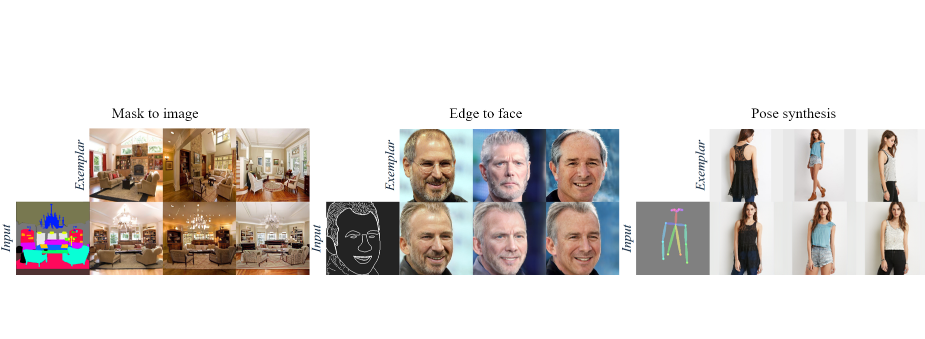Cross-domain Correspondence Learning for Exemplar-based Image Translation (CVPR 2020 oral, official Pytorch implementation)
Abstract
We present a general framework for exemplar-based image translation, which synthesizes a photo-realistic image from the input in a distinct domain (e.g., semantic segmentation mask, or edge map, or pose keypoints), given an exemplar image. The output has the style (e.g., color, texture) in consistency with the semantically corresponding objects in the exemplar. We propose to jointly learn the cross domain correspondence and the image translation, where both tasks facilitate each other and thus can be learned with weak supervision. The images from distinct domains are first aligned to an intermediate domain where dense correspondence is established. Then, the network synthesizes images based on the appearance of semantically corresponding patches in the exemplar. We demonstrate the effectiveness of our approach in several image translation tasks. Our method is superior to state-of-the-art methods in terms of image quality significantly, with the image style faithful to the exemplar with semantic consistency. Moreover, we show the utility of our method for several applications
Demo

Installation
Clone the Synchronized-BatchNorm-PyTorch repository.
cd models/networks/
git clone https://github.com/vacancy/Synchronized-BatchNorm-PyTorch
cp -rf Synchronized-BatchNorm-PyTorch/sync_batchnorm .
cd ../../
Install dependencies:
pip install -r requirements.txt
Bash
Inference Using Pretrained Model
1) ADE20k (mask-to-image)
Download the pretrained model from here and save them in checkpoints/ade20k. Then run the command
python test.py --name ade20k --dataset_mode ade20k --dataroot ./imgs/ade20k --gpu_ids 0 --nThreads 0 --batchSize 6 --use_attention --maskmix --warp_mask_losstype direct --PONO --PONO_C
Bash
The results are saved in [output/test/ade20k](https://github.com/panzhang0212/CoCosNet_Pytorch/blob/master/output/test/ade20k/0.png). If you don’t want to use mask of exemplar image when testing, you can download model from here, save them in checkpoints/ade20k, and run
python test.py --name ade20k --dataset_mode ade20k --dataroot ./imgs/ade20k --gpu_ids 0 --nThreads 0 --batchSize 6 --use_attention --maskmix --noise_for_mask --warp_mask_losstype direct --PONO --PONO_C --which_epoch 90
Bash
2) Celebahq (mask-to-face)
Download the pretrained model from here, save them in checkpoints/celebahq, then run the command:
python test.py --name celebahq --dataset_mode celebahq --dataroot ./imgs/celebahq --gpu_ids 0 --nThreads 0 --batchSize 4 --use_attention --maskmix --warp_mask_losstype direct --PONO --PONO_C --warp_bilinear --adaptor_kernel 4
Bash
, then the results will be saved in [output/test/celebahq](https://github.com/panzhang0212/CoCosNet_Pytorch/blob/master/output/test/celebahq/0.png).
3) Celebahq (edge-to-face)
Download the pretrained model from here, save them in checkpoints/celebahqedge, then run
python test.py --name celebahqedge --dataset_mode celebahqedge --dataroot ./imgs/celebahqedge --gpu_ids 0 --nThreads 0 --batchSize 4 --use_attention --maskmix --PONO --PONO_C --warp_bilinear --adaptor_kernel 4
Bash
the results will be stored in [output/test/celebahqedge](https://github.com/panzhang0212/CoCosNet_Pytorch/blob/master/output/test/celebahqedge/0.png).
#machine learning
